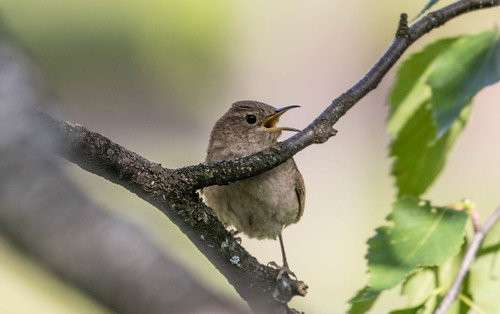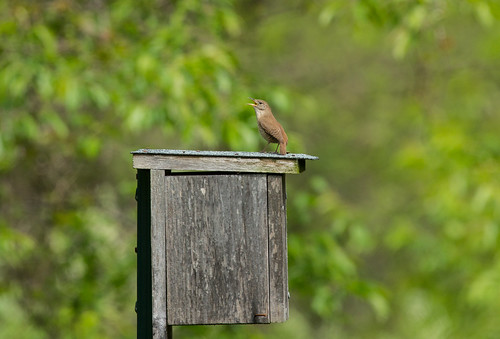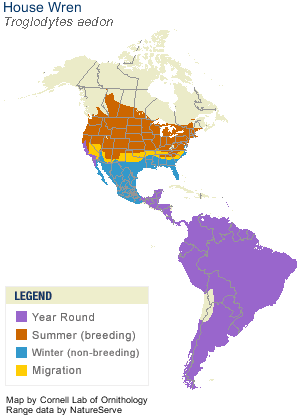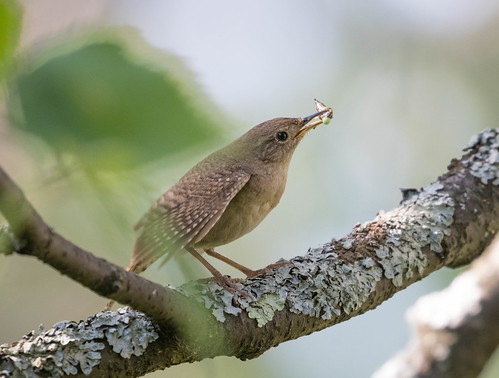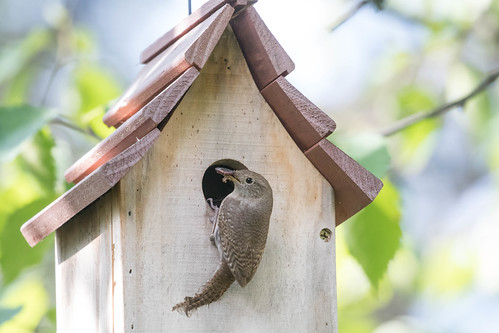Yep—2017 is Peabody Street's Year of the House Wren. We always have wrens somewhere around here, but usually just one pair at a time, and never before have more than two pairs nested on this little corner of the block. Wrens love to hear themselves sing, but like other birds, they sing more often when they hear other birds of their species sing. In normal summers I hear several singing bouts each day; this year I hear them just about any time I pay attention. I’m pretty sure I’ve heard more House Wren songs in the past two months than I heard in my previous 42 years of birding.
Before 1982, House Wrens each weighed less than 4 pennies. Nowadays, it takes closer to five pennies to balance one, not because House Wrens have followed America’s humans on the path to obesity but because the United States Mint changed the metallic composition of pennies in 1982, keeping the exact same dimensions but dropping the weight from 3.1 to 2.5 grams. Wrens average between 10 and 12 grams.
Ornithologists have studied wrens more than almost any other species because House Wrens so readily use human-made nest sites and are ubiquitous, relatively abundant across most of their range, and tolerant of human activity. House Wrens occupy the broadest latitudinal range of any native songbird in the New World, breeding from across most of Canada down to the southernmost part of South America as well as into the West Indies.
Many of us enjoy House Wrens for a more elemental reason than research: they’re so tiny, with a song that sounds so cheerfully bubbly and exuberant to our ears, that they make us happy. But wrens don’t have quite the same effect on invertebrates—their diet seems to include nothing but insects, spiders, millipedes, and other tiny arthropods.
I found two records of House Wrens helping other species: one 1968 report documented a male House Wren feeding a brood of nestling flickers. In another case documented in 1924, when a male House Wren did not attract a female to a nest box, he fed a brood of Rose-breasted Grosbeaks in their nest in the same tree, and also passed food to their parents to feed the young. He fed the baby grosbeaks for some time after they fledged, and then started feeding a brood of baby House Sparrows in another nest box.
Offsetting those two unique cases, there are a great many documented cases of House Wrens puncturing eggs, killing nestlings, and even killing adults of other species. In one study where a nest with quail eggs was set up near the nests of marked wrens, researchers found that males punctured the eggs only before they had attracted a mate; females punctured them only until they started laying their own eggs. No one knows the exact extent of this destruction, but many ornithologists believe that the decline of Bewick’s Wren in the East was due to the expansion of the House Wren range. Birds of many species are known to chase House Wrens, apparently with good reason.
I got lots of photos of the pair of wrens nesting in Jeanne Tonkin’s yard.
The longer birds care for their eggs and then nestlings, the more invested they become, and so as the nestlings have started appearing at the nest box entrance, the parents have grown much more wary of my presence. I don’t like stressing them out, so I don’t have any photos of the young looking out of the nest box. I’d rather picture in my mind’s eye little baby wrens peeking out at the big world than get a photo of it knowing their first sight was of a paparazzo upsetting their parents. The modern world poses enough stresses on birds without me adding to them.
